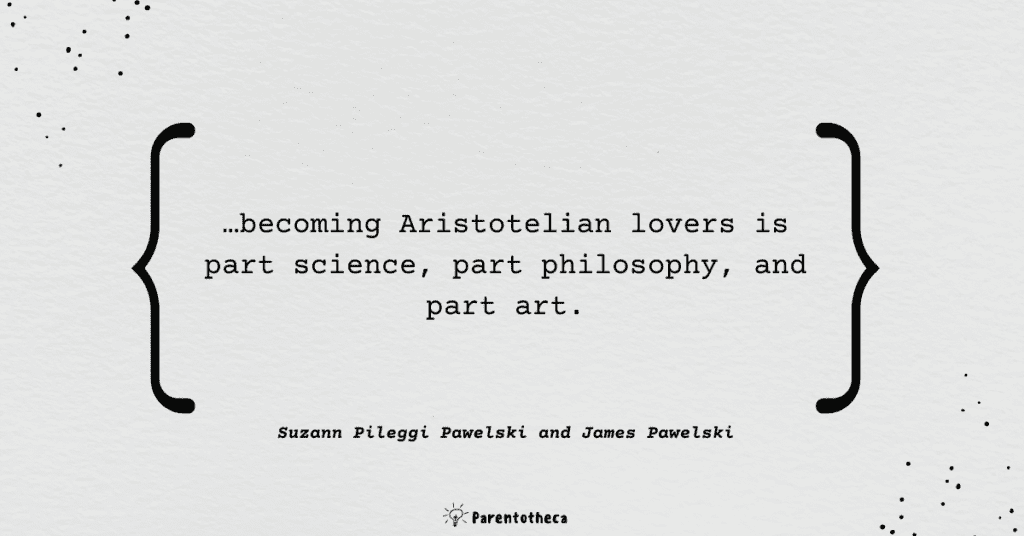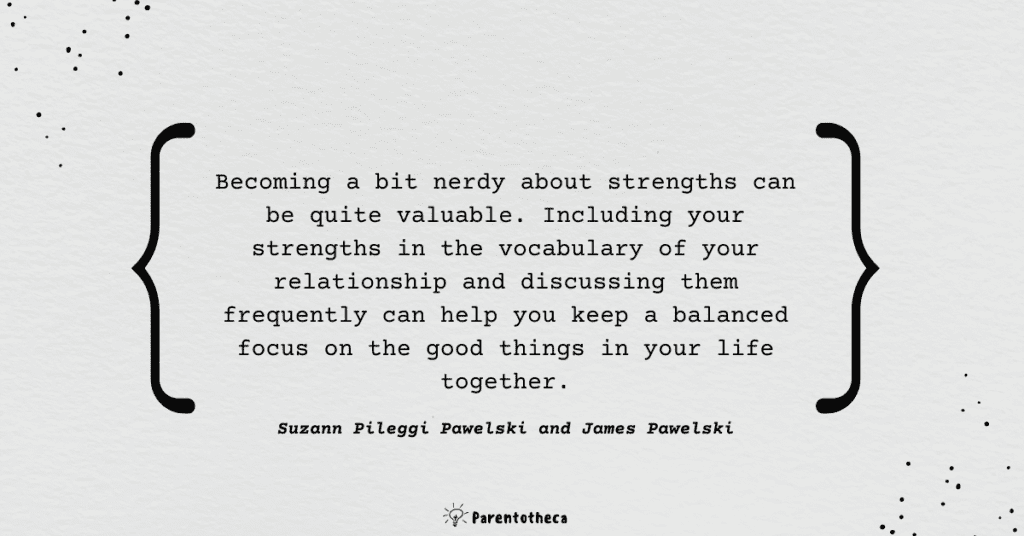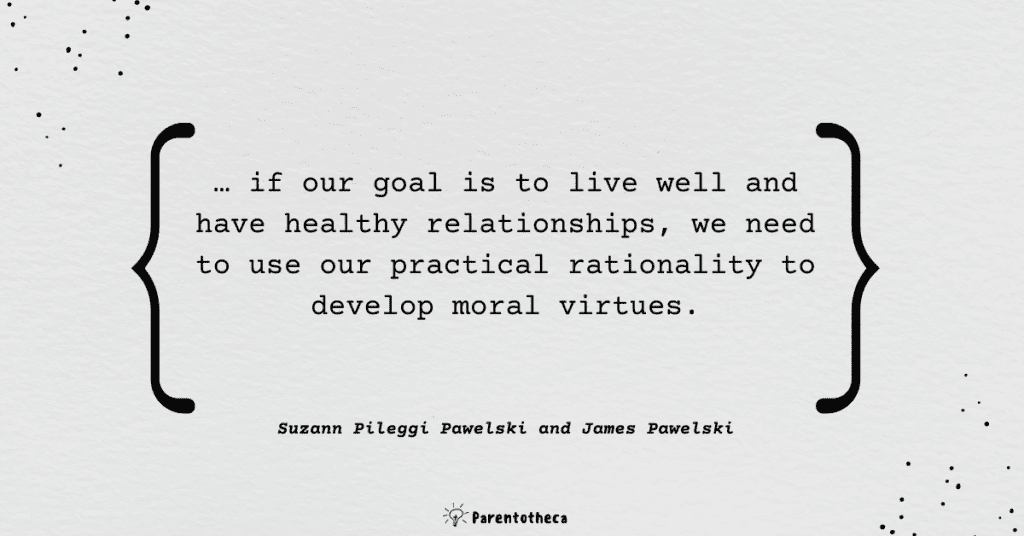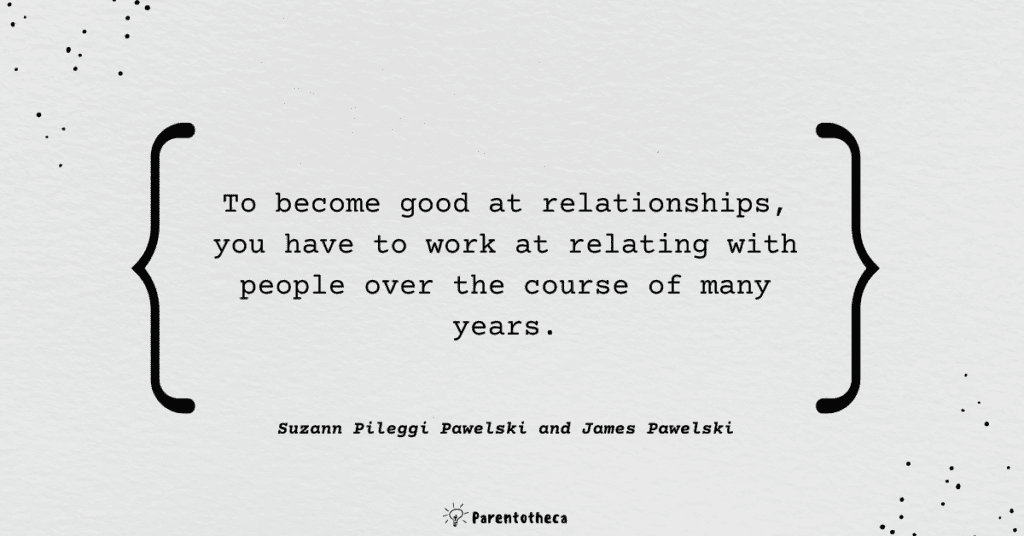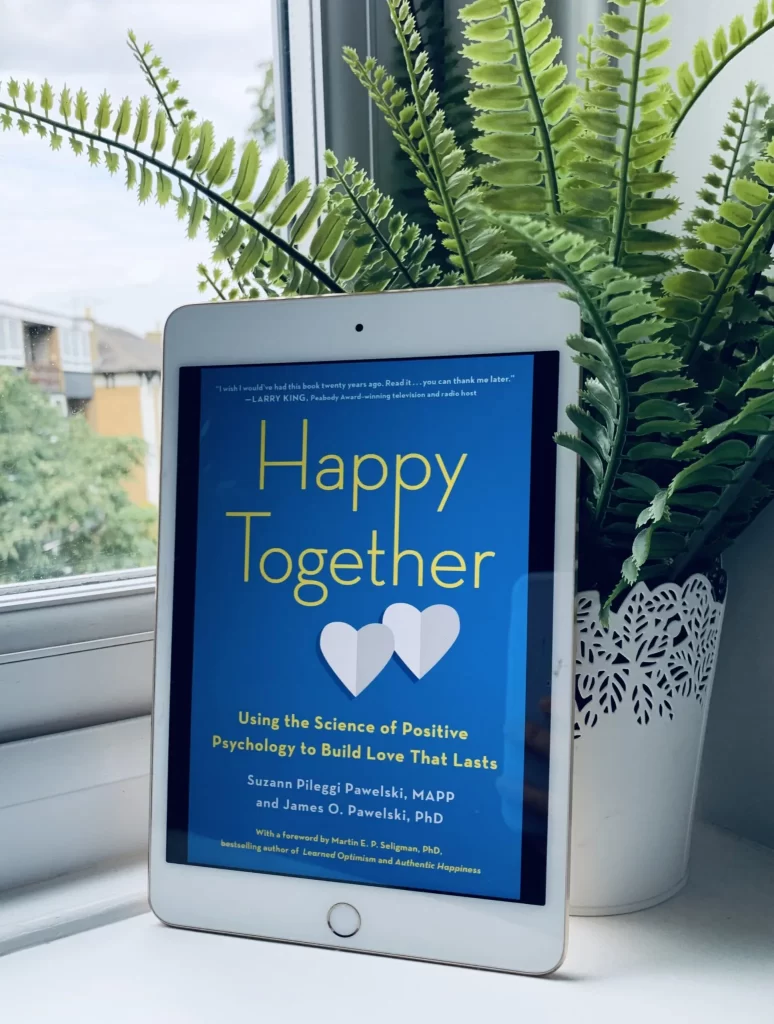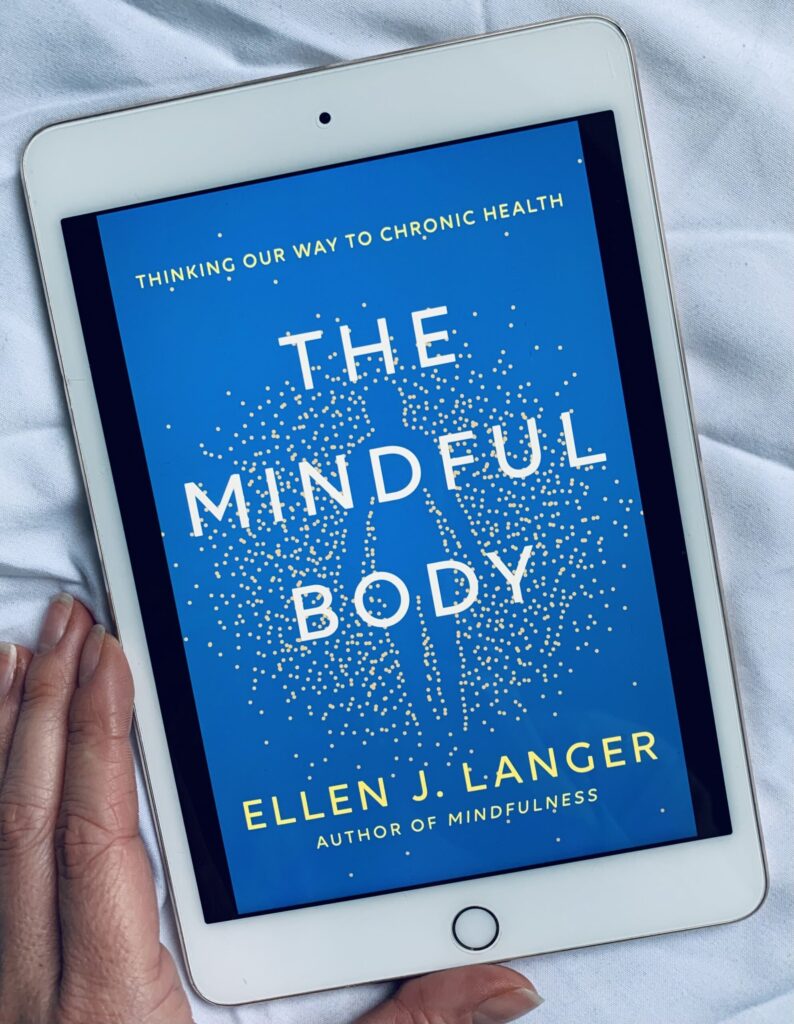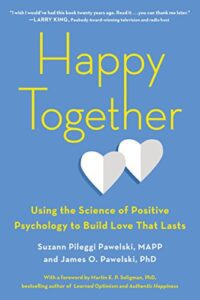 Happy Together. Book Summary.
Happy Together. Book Summary.
Using the Science of Positive Psychology to Build Love That Lasts
Suzann Pileggi Pawelski and James Pawelski
TarcherPerigee (16 Jan. 2018)
About Suzie Pileggi Pawelski and James Pawelski
Suzann (“Suzie”) Pileggi Pawelski, MAPP, is a freelance writer and well-being consultant specializing in the science of happiness and its effects on relationships and health. She has a Master of Applied Positive Psychology degree from the University of Pennsylvania. Her 2010 Scientific American Mind cover story, “The Happy Couple,” was the catalyst for this book. Suzie blogs for Psychology Today and writes the “Science of Well-being” column for Live Happy, where she is also a contributing editor. Previously, she directed award-winning media relations campaigns for Fortune 500 clients and worked in publicity at Radio City Music Hall and as an associate producer for HBO Downtown Productions and The Joan Rivers Show.
James Pawelski, Ph.D., is Professor of Practice and Director of Education in the Positive Psychology Center at the University of Pennsylvania, where he cofounded the Master of Applied Positive Psychology (MAPP) program with Martin Seligman. The Founding Executive Director of IPPA, he is currently leading a three-year, multi-million-dollar grant investigating connections between the science of well-being and the arts and humanities. An international keynote speaker, he has presented in more than 20 countries on 6 continents. He is frequently featured in the media, including the New York Times, U.S. News and World Report, Philadelphia Inquirer, and The Today Show.
About The Book
“We are now excited to be able to present this work in book format. And we offer it to all those who are—or hope to be—in romantic relationships and want to make them the happiest, healthiest, and most fulfilling they can be. We want to be clear we are not claiming that we as a couple have it all figured out, that our relationship is one blissful moment after another, and that if you follow our instructions, you too will live happily ever after. (Trust us, it’s not sunshine and rainbows all the time for us, either!) Instead of fairy-tale endings, we believe in brave beginnings and informed efforts, not so we can magically find the relationship of our dreams, but so we can wisely create beautiful relationships in the real world.
Note that this book is not titled 13 Steps to a Blissful Marriage, The Complete Guide to Happily Ever After, or Everything You Need to Know About Romantic Relationships. Although such titles seem appealing in the easy promises they offer, we believe they are fundamentally misleading. Marriages are not meat loafs, in which mastering a few steps will yield perfect results every time. Nor are they so simple that anyone can provide a complete guide to them, since each and every marriage or partnership is affected by myriad complications, starting with the two people in it. The truth is, real human relationships can be delightful, uplifting, and satisfying, yet are often messy and frustrating—and sometimes heartbreaking. The important thing to keep in mind is that, as with any human endeavor, we can get better at relationships through well-directed effort. […]
Whether you are newlyweds or newly single, whether you have been married for fifty years or have not yet been in a romantic relationship, we invite you to think of this book as an invitation to the relationship gym, where we can all benefit from the advice of psychologists and philosophers to help us actively build love that lasts.”
I am a big fan of positive psychology and believe that its core principles can be applied to every aspect of our lives. And romantic relationships are no exception.
Recently I went through the Positive Psychology course on Coursera, where James Pawelski was one of the instructors. When I discovered that James and his wife Suzie wrote an entire book on relationships, I got it immediately. Needless to say, it is awesome.
In Happy Together, James and Suzie teach us how to apply the principles of positive psychology to create thriving relationships that last a lifetime. Drawing on extensive scientific research, ancient wisdom and real-life examples, Pawelskis encourage us to find the good in ourselves and our partner and show us how we can develop great habits to master the complex art of relationships.
The book is packed with practical methods and exercises, so all you have to do is just turn them into habits.
Science + Ancient Philosophy + Practical Tools. Perfect combination!
I highly recommend this book to everyone who wants to have happy and fulfilling relationships in their lives (well, who doesn’t?). It will definitely help you become a better person, a better partner and a better parent as well.
The book is full of great ideas, so let’s jump straight to our favourite ones.
Key Insights:
Relationship Gym
“We believe in the importance of working on our relationships just like we work on our bodies at the gym. Fitness doesn’t come magically; it’s the result of sustained effort. And this effort needs to be directed wisely. This is why we turn to trainers for advice. And any good trainer will tell you how important it is to develop good exercise habits that can make it easier to get to the gym and keep going on our routines. This is true of relationships, as well. Sustained efforts and habits are essential. And once we begin to see the fruits of our labor, and enjoy greater understanding and better interactions with our partners, we naturally become motivated to work even harder. Eventually, the hard work doesn’t seem to be so ‘hard’ or ‘work’ at all, but rather becomes natural and fun behavior we want to keep doing.”
Relationship gym – love this metaphor. Of course, falling in love is quite easy. And that’s something we see in the fairy-tales all the time. But standing in love is much harder. Because relationships are probably one of the most complicated things in the world. And to master the complex art of relationships, you have to put in a lot of effort.
So if you want to turn your romantic dream of “happily ever after” into a reality, you’ll have to sweat in the relationship gym. The good news is that you can use plenty of science-proved strategies for your deliberate practice.
Practice. Practice. Practice.
Aristotelian Lovers
“Inspired by Aristotle’s insights about friendship, our ideal for romantic relationships is the goal of becoming Aristotelian lovers. In this ideal, relationships are characterized by three interrelated elements.
First, partners love the good they see in each other. This does not mean they ignore the benefits that can arise from their relationship, or the pleasure that may come from being in each other’s company. But their relationship is not founded on these things. And loving the good they see in each other does not imply that they expect their partner to be perfect or that they are naively blind to their partner’s flaws.
In fact, being particularly adept at seeing the good in each other no doubt makes Aristotelian lovers especially good at the second element that characterizes them: They are committed to each other’s well-being and supportive of their growth. Because they see the good in each other so clearly, they also have a unique perspective on their true potential, and they do what they can to help each other achieve it. This does not mean that they demand their partner change or try to force them into their own view of what they should be. Rather, they provide support and perspectives to help their partner do their own growing.
Third, Aristotelian lovers are inspired to become better people themselves. They value the ways their partner’s unique character and patient love help them see more clearly what it means to be a good person and how they themselves can realize more of their own potential. They realize this is something they will need to work at, and don’t simply rely on their partner to do it for them. But they welcome the partnership and the support toward mutual growth.”
Suzie and James look at relationships through the prism of Aristotelian friendship (which makes a lot of sense as we all want our partner to be our friend first of all). And isn’t it brilliant?
A healthy and lasting relationship is all about growing together and supporting each other on the way to eudaimonia. Add tools you can use to turn theory into practice, and you are all set for the “happily ever after”.
P.S.: This perspective actually made me reflect on how we can apply this to parenting. Probably, if we can be Aristotelian lovers in romantic relationships, we can also aim at becoming Aristotelian parents. When we see good in our children, value their character and want to help them continue to grow and develop in healthy directions, we can set a solid foundation for thriving in life.
4 Areas That Are Crucial in Making a Relationship Last
Integrating ancient wisdom and insights from positive psychology research, the Pawelskis highlight four areas that are crucial to building and sustaining love over the long run:
- Passion fuels our relationships and pretty much every other aspect of our life. Happy couples know how to cultivate the right kind of passion in their relationship. Harmonious passion is all about remembering who we are as individuals and creating opportunities for adventures together that we both enjoy.
- Positive emotions are essential for building any kind of relationship and are also super important for love, as they motivate couples to care for each other and invest in each other’s well-being. “They help us forge strong connections with others by breaking down boundaries that separate us from each other.” Couples feel more connected and happy when they continually kindle positive feelings in their relationships.
- Savoring helps us make the most of positive emotions and other great experiences. Mindful savoring is about actively and consciously valuing each other and expressing this admiration to strengthen a relationship. In fact, happy couples not only nurture “fondness and admiration” for each other but also celebrate the good times and the good things each of them does.
- Character: Knowing our character strengths and cultivating them daily is a sure way to a happy and fulfilled life. What research also suggests is that when you recognize and appreciate your partner’s character strengths, “you are more likely to be happy in your relationship, have your psychological needs met, and be more sexually satisfied.” (you can explore your character strengths for free here, also, check out The Science of Character video)
In the book, Suzie and James, chapter by chapter, tell us how we can put all this theory into practice and share great exercises we can try to nurture our romantic relationships. In these notes, we’ll cover just a few ideas, so definitely grab the book for more (it is fantastic!).
Raise Your Positivity: Top 10 Positive Emotions For Relationships
“Positive emotions are more than pleasant feelings to enjoy; they can also have ongoing positive consequences in our lives, like making us more creative. And although we often think of positive emotions as being the result of good things happening in our lives, they can cause good things to happen, as well. In the context of relationships, positive emotions are not simply indicators that things are going well; they can also help us take actions that will keep the relationships healthy.”
Want flourishing relationships and more well-being in your life? Learn how to cultivate positive emotions. Here is the research-backed tip number one: instead of prioritizing happiness in your relationship (and life in general), prioritize positivity. Here is the list of top 10 positive emotions that you can focus on:
Interest
Amusement
Joy
Hope
Serenity
Gratitude
Pride
Inspiration
Awe
Love
Positivity takes work, so make decisions and organise your life in ways that are likely to result in the experience of positive emotions (and make it a habit!).
Another scientifically proven strategy for raising your positivity is acting how you want to feel: pick an emotion from the list above and turn into an actor (reflecting on the occasions when you felt this emotion would help a lot)!
And remember: emotions are contagious – so cultivate positivity in your life and spread the joy to your partner (and your kids!).
SNAP – Developing Good Habits in Relationships
“Of course, developing good habits in our relationship is far easier said than done. William James presents four maxims to help us in this endeavor. And James Pawelski has created an acronym to make them easy to remember: SNAP.
1. Start strong. The more highly motivated we are to start a new habit, the more likely we are to be successful. One way to increase our motivation is to make a public announcement of what we are going to do. That makes it easy for our friends to support us in achieving our goal and hard for us to go back on our intentions.
2. No exceptions. We may think that once we have acted in accordance with the new behavior for a few days, we can give ourselves a break. But James argues that this is likely to make us have to start the process all over again.
3. Always act. Whenever we have an urge to act in accordance with the new habit, we should follow that urge, no matter how annoying it may seem.
4. Practice exercising the will. James suggests doing something hard every day, for no reason but that it is hard. Doing so, he says, can strengthen the will, making it ready for our use when we need it.”
One more framework for making good habits stick (and I think the acronym SNAP is brilliant). To me, it resonates a lot with Darren Hardy’s approach in The Compound Effect and, of course, with James Clear’s four laws of habit loop in Atomic Habits (check out our notes for more).
On How to Receive Gratitude
Gratitude is one of the strongest positive emotions, and as research suggests, it profoundly impacts our relationships and well-being in general.
Now. Feeling grateful for your partner taking kids on a day trip to a museum so you could spend the whole day in SPA is one thing. And expressing your gratitude to him is another. So want a happy marriage? Make sure you share your appreciation with your other half each time you FEEL grateful.
At the same time, the authors note that while expressing gratitude is important for happy relationships, the way we receive gratitude from our partner is also a big thing.
In the book, Suzie and James invite us to reflect on how we react to gratitude from our partner (and from other people as well). In short, people tend to respond to gratitude in a relationship in six ways:
(1) deflection – just brushing off the gratitude; (2) reciprocation – acknowledging the gratitude and immediately jumping into own expression of gratitude (like “hot potato”); (3) discounting – “thanks, but…” response (e.g. “thank you for this delicious dinner! I really appreciate your taking the time to make this meal”, “Thanks, but it should have been better. I didn’t have all the ingredients, and the meat got burned from one side.”; (4) acceptance – pausing and taking the gratitude in with a simple “thank you!”; (5) amplification – “this is where you don’t just accept the gratitude, but you take it in deeply and savor it, absorbing all of its rich qualities and letting it permeate your being.”; (6) advancement – “when we take the expression of gratitude or appreciation as an opportunity to connect more deeply about something that is important to both of us.”
Guess which three ways are the best to respond to gratitude?
“Acceptance is opening a door to genuine connection with another person, amplification is taking in and appreciating the view it affords, and advancement is walking through the door and exploring new possibilities for deeper communication and greater insights.”
Question for you: how do YOU respond to gratitude from your partner?
P.S.: if you feel inspired, check out our article on gratitude in a relationship.
Know Thyself (and Know Thy Partner)
“In this chapter, we will explore our signature strengths in greater detail. Initially, we will focus on understanding and developing the strengths of each person in the relationship, then we will focus on integrating both partners’ strengths so that the whole becomes more than the sum of its parts. This is particularly important because research suggests that when you recognize and appreciate your partner’s character strengths you are more likely to be happy in your relationship, have your psychological needs met, and be more sexually satisfied. (That got your attention, didn’t it?) You’ll want to make sure you know your own signature strengths, as identified by the VIA Survey. And if you’re reading this book with your partner, you will want to know each other’s, as well. So if you haven’t yet taken the survey, we invite you to pause right now and do so.”
Character is a huge topic in Positive Psychology. Why? Because it is a big part of who we are and how we relate to others. Knowing what our character strengths are and how to cultivate them can help us “guide our lives and direct our efforts in ways that are likely to yield the greatest results.” And knowing our partner’s character strengths can help us avoid frictions and frustrations that can arise from differences in our personalities. And most importantly, it can help to make our life and relationship better.
So, do you know your signature strengths? If not yet, spend an evening going through the VIA Survey together with your partner and build your relationship habits around each other strengths (e.g. setting up a strengths date, sharing with your partner your strengths stories, strengths conversations, etc.).
P.S.: In Flourish, Martin Seligman (the founder of Positive Psychology) describes how focusing on signature strengths in schools influences young people. So if you have kids, definitely do the VIA Survey all together and help each other develop a good character. You can also incorporate your family’s character strengths into the Family Manifesto.
Key Takeaways:
- Take up new and interesting activities together as a couple and seek out new adventures together.
- Explore your and your partner’s character strengths (here, you take the VIA Survey) and set up a strengths date: “Select one of your signature strengths and one of your partner’s signature strengths and plan a single activity that will let each of you put that strength into practice. After the activity, discuss how it went. In what ways did it work well for each of you? What can you learn from this occasion to help you plan your next strengths date?”
- Prioritise positivity and cultivate positive emotions in your life (and relationships).
Quotes From The Book:


